Unit 4Body Language(reading)
高中英语必修四4_Unit4_Body_language_Reading新人教版

A conclusion of the passage.
Careful reading
( Read para1-2 Find out the answers to the questions)
1 Who will be present at the meeting?
people from different countries
a Japanese The second mistake
George Cook from (Canada)
He ________ bowed to Mr. Cook and his nose touched Mr. _________ moving Cook’s _______ ________. hand He ________ reached his hand ________ _______ ________ to the out Japanese.
Para.1-2 (example)
people present local businessmen
people representing the Chinese government
2 Why are people visiting China?
purpose mistakes
interest
People from different countries misunderstand each other.
He approaches Ms Smith Mr. Garcia by touching _______ ______ her from The _________ _______ shoulder and kissing (Columbia ) first her on the ________. cheek mistake She ______ stepped ________ back Julia Smith appearing surprised _________ from and take a few steps (Britain) away from _______ ______ Mr. Garcia.
人教版高中英语必修四 Unit4 Body Language reading 课件

Para1 Body language is one of the most powerful means of communication, often even more powerful than spoken language. People around the world show all kinds of feelings, wishes and attitudes that they might never speak aloud. It is possible to "read" others around us, even if they do not intend for us to catch their unspoken communication. Of course, body language can be misread, but many gestures and actions are universal.
but many gestures and actions are universal. Para7 With so many cultural differences between people, it is great
to have some similarities in body language. We can often be wrong about each other, so it is an amazing thing that we understand each other as well as we do!
Para7 With so many cultural differences between people, it is great to have some similarities in body language. We can often be wrong about each other, so it is an amazing thing that we understand each other as well as we do!
人教新课标必修四 Unit 4 body language-Reading[阅读课件]
![人教新课标必修四 Unit 4 body language-Reading[阅读课件]](https://img.taocdn.com/s3/m/5bc2513a7375a417876f8f09.png)
Words preview represent vt. 代表; 象征
association n. 社团;teen n. 食堂
flight n. 飞行; 航班 curious adj. 好奇的
Words preview curiously adv. 好奇地 Colombia n. 哥伦比亚 approach vt. & vi. 接近; 靠近; 走近 n. 接近; 方法; 途径 cheek n. 面颊 defend vt. 保护; 保卫 defence n. 防御; 保卫
8. In general, though, studying international customs can certainly help avoid difficulties in today’s world of cultural crossroads.
1.Yesterday, another student and I, representing our university’s student association, went to…
学生会 在北大学习 学生食堂 环顾四周 后退 防卫地;戒备地 飞快地穿过 正相反 朝…点头 很可能…;有希望… 大体上,一般来说,通常
既不……也不…… not…nor… 把……介绍给…… introduce…to… 亲吻某人脸颊
做……的方法
kiss sb. on the cheek
the /an approach to doing sth. / the way to do sth.
凡去参观长城的人请在这儿报名。
(2) 由only, last, next, 序数词或形容词最高级修饰的
Unit 4 Body Language Reading教学设计
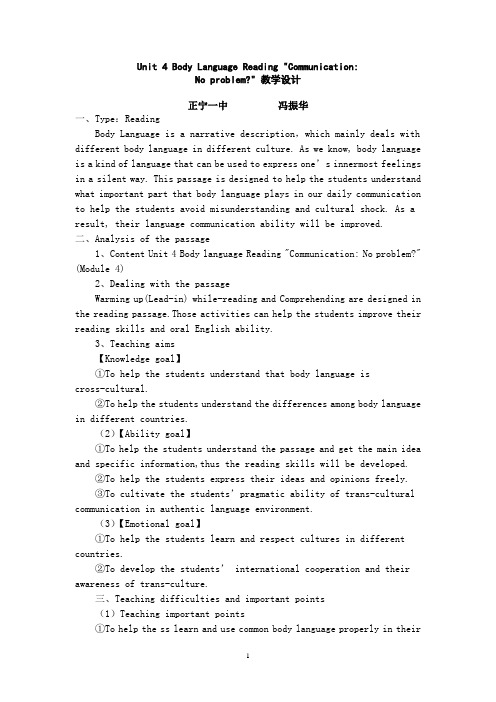
Unit 4 Body Language Reading "Communication:No problem?" 教学设计正宁一中冯振华一、Type:ReadingBody Language is a narrative description,which mainly deals with different body language in different culture. As we know, body language is a kind of language that can be used to express one’s innermost feelings in a silent way. This passage is designed to help the students understand what important part that body language plays in our daily communication to help the students avoid misunderstanding and cultural shock. As a result, their language communication ability will be improved.二、Analysis of the passage1、Content Unit 4 Body language Reading "Communication: No problem?" (Module 4)2、Dealing with the passageWarming up(Lead-in) while-reading and Comprehending are designed in the reading passage.Those activities can help the students improve their reading skills and oral English ability.3、Teaching aims【Knowledge goal】①To help the students understand that body language iscross-cultural.②To help the students understand the differences among body language in different countries.(2)【Ability goal】①To help the students understand the passage and get the main idea and specific information,thus the reading skills will be developed.②To help the students express their ideas and opinions freely.③To cultivate the students’pragmatic ability of trans-cultural communication in authentic language environment.(3)【Emotional goal】①To help the students learn and respect cultures in different countries.②To develop the students’ international cooperation and their awareness of trans-culture.三、Teaching difficulties and important points(1)Teaching important points①To help the ss learn and use common body language properly in theircommunication;②To get the main idea of the text and some key information.(2)Teaching difficulties①To cultivate the students’ reading skills②To help the students learn some cultural misunderstanding caused by body language in different situations.四、Teaching methodTask-based method & Communicative-cooperation method五、Teaching aidsPPT Project Blackboard Chalk六、Teaching design(一)General designThis is a reading comprehension lesson. The key to teaching is to improve the students’ reading skills and strategies. And the teacher will help the ss improve their cultural awareness.To arouse the ss’ interest in the topic, at the very beginning of the class,the teacher uses the students’ familiar gestures (ok, quiet, stop, great) to lead in the topic and asks some students to guess the meaning of each picture. Then the teacher asks some students to perform some body language, thus the atmosphere in the class is lively. At last,the teacher asks the ss: “What is body language?” As a result ,the new lesson is easily lead-in. The design of the reading activities deals with pre-reading, while-reading and post reading, including getting the main idea of the text, specific information and so on , aiming at improving ss’ reading comprehension ability and oral English ability.(二)Teaching proceduresStep 1.Leading in(1)The teacher shows some pictures on the screen. They are about some common gestures used in our daily life. Then asks some ss to guess the meaning of each gesture.(2)The teacher asks some pairs of students to come to the blackboard to perform some body language, while other students to guess what the body language means.Facial expressions: happy, excited, shocked, angry, etcGestures: Victory, well done, quiet, OK, etcPostures: Shake hands, bow, nod ,hug, etcEye contact: Wide-eyed, wink, roll eyes, etcInstructions:通过学生熟悉的手势导入本课,让学生倍感亲切,很自然地过渡到本课的话题。
新人教版高中英语必修4Unit 4 Body Language Reading(含答案)

高一英语同步练习:必修4 Unit 4 Body Language第2课时Reading基础练习1.Scanning: Find the characters and where they are from?Character Country____________________________________________________________________________ ____________________________________________________________________________ ______________________________________2.Fast-reading : Does body language stay the same in different countries / cultures ? Why?3.Careful reading:read the text, fill the graphCountry Ways to greet each otherBritain ________________________Canada ________________________Japan ________________________Spain, Italy, South American countries________________________________France________________________________________________________________Men from Middle East and other Muslim cultures实战演练一. 英汉互译1. Yesterday, another student and I, representing our university’s studentassociation, went to the Capital International Airport to meet this year’s international students.______________________________________2.我看见几个年轻人走进了等候区,好奇地四周张望。
高中英语人教版必修四unit4_Body_language-reading公开课课件ppt课件
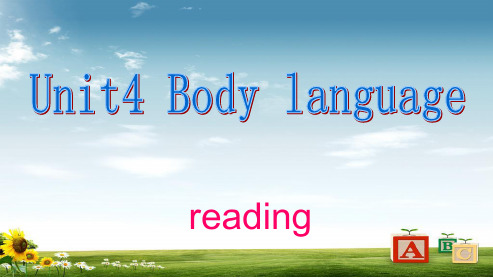
Part 3: (Para 4 )
Part 4: (Para 5)
D) Examples of learned or cultural “body language”.
Matching the people and the different ways of greeting (para2&5)
Tony Garcia (Columbia) Julia Smith (Britain) Akira Nagata (Japan) George Cook (Canada)
Careful reading :
shakes hands and kisses others twice on each cheek Bows
shakes hands approaches others closely and touches their shoulder and kisses them on the cheek does not stand very close to others or touch strangers
Columbia
Britain
Julia Smith
George Cook Akira Nagata
Canada
Japan Jordan
Ahmed Aziz
Darlene Coulon
You
France China
Fast reading:
Which is the main idea of the text?
reading
Come here !
Good ! / Great !
“No,You can not do that"
OK
• She is deaf and dump, so body languagee.
Unit 4 Body Language_Reading 体现学科核心素养的教学设计.
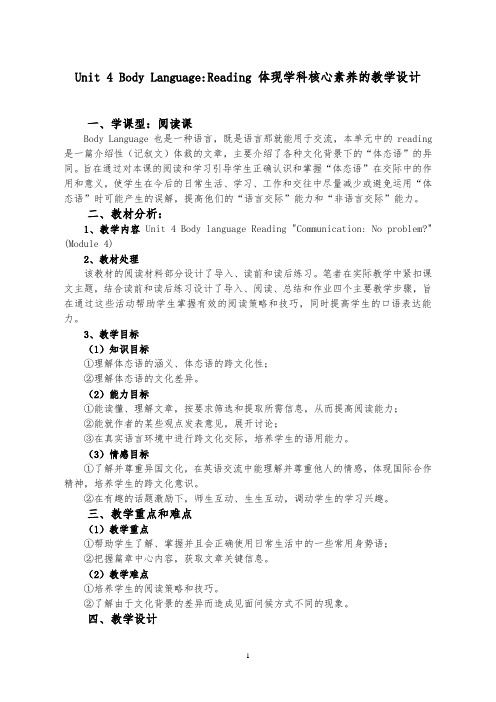
Unit 4 Body Language:Reading 体现学科核心素养的教学设计一、学课型:阅读课Body Language也是一种语言,既是语言那就能用于交流,本单元中的reading 是一篇介绍性(记叙文)体裁的文章,主要介绍了各种文化背景下的“体态语”的异同。
旨在通过对本课的阅读和学习引导学生正确认识和掌握“体态语”在交际中的作用和意义,使学生在今后的日常生活、学习、工作和交往中尽量减少或避免运用“体态语”时可能产生的误解,提高他们的“语言交际”能力和“非语言交际”能力。
二、教材分析:1、教学内容 Unit 4 Body language Reading "Communication: No problem?" (Module 4)2、教材处理该教材的阅读材料部分设计了导入、读前和读后练习。
笔者在实际教学中紧扣课文主题,结合读前和读后练习设计了导入、阅读、总结和作业四个主要教学步骤,旨在通过这些活动帮助学生掌握有效的阅读策略和技巧,同时提高学生的口语表达能力。
3、教学目标(1)知识目标①理解体态语的涵义、体态语的跨文化性;②理解体态语的文化差异。
(2)能力目标①能读懂、理解文章,按要求筛选和提取所需信息,从而提高阅读能力;②能就作者的某些观点发表意见,展开讨论;③在真实语言环境中进行跨文化交际,培养学生的语用能力。
(3)情感目标①了解并尊重异国文化,在英语交流中能理解并尊重他人的情感,体现国际合作精神,培养学生的跨文化意识。
②在有趣的话题激励下,师生互动、生生互动,调动学生的学习兴趣。
三、教学重点和难点(1)教学重点①帮助学生了解、掌握并且会正确使用日常生活中的一些常用身势语;②把握篇章中心内容,获取文章关键信息。
(2)教学难点①培养学生的阅读策略和技巧。
②了解由于文化背景的差异而造成见面问候方式不同的现象。
四、教学设计(一)总体设计本节课是阅读课,教学重点是培养学生的阅读策略和技巧,同时引导学生用所学语言知识及写作技巧完成课后的书面表达练习。
高中英语新人教选修一选择性必修一Unit 4 body language Reading阅读要点讲解

凭借/通过/靠做某事
the way people stand, hold their arms, and move their hands can alsut their feelings.
interaction
词性
相关 词汇
n. 交流;相互影响 interact v. 互相影响;互动
1. Body language plays an important role in social interaction.
例句感知
2. There will be a true global village in which telephones, computers and televisions interact.
Para.1
LISTENING TO HOW BODIES TALK
We use both words and body language to express our thoughts and
opinions in our interactions with other people. We can learn a lot about what
例句感知
Para.1
LISTENING TO HOW BODIES TALK
We use both words and body language to express our thoughts and
opinions in our interactions with other people. We can learn a lot about what
人教新版高中英语选择性必修一Unit 4 Body Language---reading 教学设计
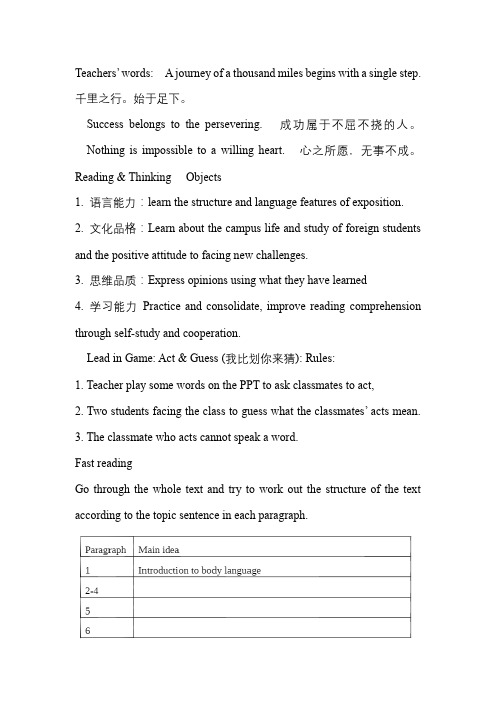
Teachers’ words: A journey of a thousand miles begins with a single step.千里之行。
始于足下。
Success belongs to the persevering. 成功属于不屈不挠的人。
Nothing is impossible to a willing heart. 心之所愿,无事不成。
Reading & Thinking Objects1. 语言能力:learn the structure and language features of exposition.2. 文化品格:Learn about the campus life and study of foreign students and the positive attitude to facing new challenges.3. 思维品质:Express opinions using what they have learned4. 学习能力Practice and consolidate, improve reading comprehension through self-study and cooperation.Lead in Game: Act & Guess (我比划你来猜): Rules:1. Teacher play some words on the PPT to ask classmates to act,2. Two students facing the class to guess what the classmates’ acts mean.3. The classmate who acts cannot speak a word.Fast readingGo through the whole text and try to work out the structure of the text according to the topic sentence in each paragraph.Careful reading & DiscussionTask 1: choose the best answers by yourself.1.What’s the function of the last sentence in Paragraph 1?A. Introduce the background of language.B. Showing words are more important than body language.C. Introduce the topic of this passageD. Making comparison between words and body language. 2.The purpose of the second paragraph is?A. Tell us how important body language is.B. To show an identical gesture may have different meanings in different cultures.C. To stop men and women making eye contact while talking.D. To remind us to look down while talking to an older person to show respect.3.The gesture “ok” means _______ in France?A. MoneyB. RudenessC. ZeroD. Favour.4.Which statement does the author possibly agree with?A. Never too old to learnB. Four eyes see more than two.C. Every country has its own customsD. When in Rome, do as Romans do.Task 2: Fill the blanksTask 3: answer the following questions by yourself and then discuss with your partners.1、Go over the topic sentences in Para 2-5 and identify how each paragraph is developed. Discuss with your partner and draw a mind-map.2、From the last paragraph, we know that smiling has different uses. Can you think of some other uses of smiling?(try to write more than 2 sentences)1)A smile can...2)We can use a smile to3)Sb suggest smiling at/ sb suggest (that) smiling4)There is nothing better than seeing the smiling face of ...when/if we are.. Summary Besides words, body language can also give us informationabout feelings.However, it varies ___1___ culture to culture. For example, making eye contacttogether with the gesture for “ok”, “yes” and “no” ___2___(differ) around theworld. For example, in many Middle Eastern countries, men and women are not___3___(social) permitted to make eye contact. In Japan, it may show respect to look down when speaking with the older people. There are also differences in how we touch each other, how close we stand to someone we ___4___(talk) to and how we act when we meet or part. In countries like France and Russia, people may kiss their friends on ___5___cheek when they meet while in other countries of the world people approve of ___6___(shake) hands, bowing or nodding. Of course, some gestures have the same meaning everywhere. For example, placing hands together and resting them on the side of our head with our eyes closed means “sleep”. If we are full after a meal, we can move our hand in___7___(circle) over our stomach. On the other hand, some body language has many different uses. Perhaps the best example is smiling, ___8___ can help us get through difficult situations, find friends and break down barriers. You can also make ___9___(you) feel happier and stronger by smiling. If you feel down, there is nothing___10___(good) than seeing the smile of your good friend. Post-readingRole Play: 学生四人一组,一人扮演中国学生,另三人分别扮演来自日本、法国和中东的国际交流生。
Unit4BODYLANGUAGEReadingAndThinking(教学设计)高二英语(人教版2
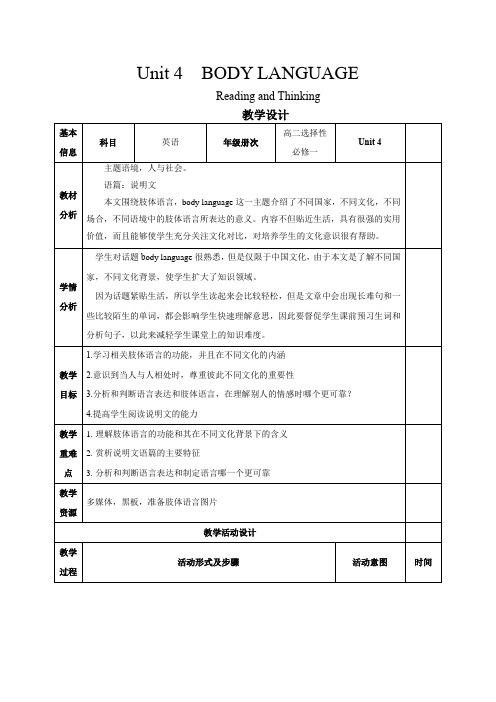
Unit 4 BODY LANGUAGEReading and ThinkingStep1. LeadinShow pictures to recall their performancesStep2. Reading .Prereading Act and GuessChoose the students to act the sentences out without speaking.Go away !Come here !I’m tired !I’m surprised !You’re great !Goodbye!提前给学生发小卡片,让学生在课堂上表演出来,以免影响表演效果。
whilereadingLet’s summarize the main idea of these paragraphs.分析文本结构,学生总结ntroduction to body language2.Body language with different meanings in different cultures3.Body language with the same meaning everywhere4.Body language with different usesRead for detailsParagraph 24Read for detailsParagraph 56postreadingAnswers1. Introduction2. differences3. similarities4. different usesStep3 : Thinking分两组展开讨论,训练学生语言学习效果和批判性思维Which is more reliable ,body language or spoken language ?Tipshold their anger and disappointmentfar more important than what we sayinclude the impression on our faces, eye contact and gestures nod or shake our headsmake eye contactthe key to a successful social lifeStep 4 SummaryChoose the best answers.1. What is the genre/type of the passage?A narrationB argumentationC exposition 记叙文议论文说明文D news report2.How does the passage develop ?。
新人教版高中英语必修4 Unit4_body_language_reading

Warming Up
What is the purpose of language?
To communicate with each other.
Ways of communicating
Spoken speaking language ringing
Written writing language typing
Do you know the meaning of the following gestures ?
Stop!
Come It’s ok. You are very
here.
good.
Bye-bye.
/ Well done!
Do you know the meaning of the following body movements ?
3. In general, studying __in__te_r_n_a_t_i_o_n_a_l c_u__s_to__m_s___ can certainly help _a_v_o__id_ _d_i_ff_i_c_u_l_ti_e_s____ in today’s world of cultural crossroads!
Part 3. (Para. 4)
Meet the visitors at the airport.
Part 4. (Para. 5)
People from different countries express greetings in different ways.
Detailed reading : Para1
What can you learn from this passage?
Unit+4+Body+Language+Reading+for+人教版(2019)选择性必修第一册
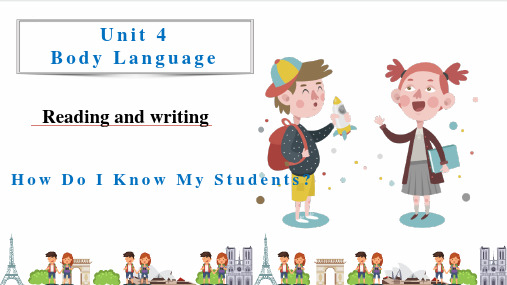
Some students are amused by something else. They spend P4 all their time looking anywhere but at me. Then again, some
students' favourite activity is daydreaming. With their chins on their hands, they occupy themselves by staring out of the window or up at the ceiling. They are certainly interested in something, but who knows what. The main thing is reminding distracted students that they need to pay attention in class.
really interested, however, because they lean forward and look at me. People
have a tendency to lean towards whatever they are interested in. So if a
student has his head lowered to look at his watch, it implies he is bored and
1. Topic sentence. 2. Body language &implication.
While it is easy to perceive when students are interested, bored, or
Unit4BodyLanguagereadingReadingandThinking导学案-高中英语

选修一Unit4 reading导学提纲(第一课时)班级:姓名:使用时间:_____________【学习目标】1.Get a better understanding of body language by grasping the main points of the passage.2.Develop the ability to identify the topic sentence in a para and figure out the structure ofa passage.3.Develop a sense of crosscultural munication by identifying the feature of body language.一、导1.在与他人交流时_______________2.因文化而异_______________________3.与…文化相适应___________4.眼神交流;眼神接触_______________5.表示兴趣_________________6.相比之下__________________________7.被认可_____________ 8.被允许做某事______________________9.表示尊重___________ 10.向下看;蔑视_______________________11.使用这个手势_________ 12.遇到同一种手势___________________13.避免做某事____________ 14.摇头__________________________15.与…相比较_________ 16.相反的含义_______________________17.亲吻某人的脸颊__________ 18.喜欢做某事__________________________19.弯腰鞠躬___________________ 20.点头__________________________21.用手转圈___________________ 22.度过难关__________________________23.打破障碍/隔阂___________ 24.感到沮丧和孤独_______________________二、思、议、展、评Activity1: PredictionWhat do you think will be talked about the text?Activity2: Fast ReadingListen and try to answer the following questions:1. What is the main idea of the text?A. The cultural similarities of body languageB. The differences between body language and spoken language.C. The characteristics of body languageD. Body language in different cultures 2. What’s the type of the passage?A. A narrationB. An argumentationC. An expositionD. An application3. what’s the structure of the passage?A. B. C.①①②①②③④⑤⑥③④⑤⑥②③④⑤⑥4. Match the main idea with each part.Para.1 A. The same gesture may have different meanings in different countries.Para.2 B. Smiling has many different uses.Paras.34 C. Body language varies from culture to culture.Para.5 D. Both words and body language are of importance in interactions with others.Para.6 E. Some gestures seem to have the same meaning everywhere. Activity3: Careful ReadingPara.1:1.Can you guess the meaning of the word “interaction”according to the context?2.What is the function of the last sentence in Paragraph 1?Para.6:Find the difference uses of smiling:三、合作探究——议、展、评Activity 4:DiscussingCan you think of some other uses of smiling?四、随堂检测——检1. How is the passage developed?(四选二)A. By giving dataB. By making parisonC. By giving examplesD. By giving definitions2. Which statement does the author possibly agree with?A. Never too old to learn.B. Four eyes see more than two.C. Action speaks louder than words.D. When in Rome, do as the Romans do.3. Fill the blanks with correct words or the correct forms of the given words.We use both words and body language __________(express) our thoughts and opinions in our ____________(interact) with other people. Just like spoken language, body language _________(vary) from culture to culture. The crucial thing is _________(use) body language in a way that is appropriate to the culture you are in. For example, _______ (make) eye contact is not appropriate to all cultures. Some gestures like the one for “OK’ have dfferent meanings in different cultures. Even the gestures we use for “yes”and “no”differ around the world. There are also differences ______ how we touch each other, how close we stand _____ someone we are talking to, and how we act when we meet or part. Such gestures _____ the ones for “sleep”and “I am full” seem to have _____ same meaning everywhere.Some body language has many different uses. One example is smiling.五、总结归纳——结(本节课知识点归纳,学生当堂背诵)Recite the key words and phrases of this passage.。
新人教版高中英语必修四Unit4 Body Language Reading教学反思与心得体会
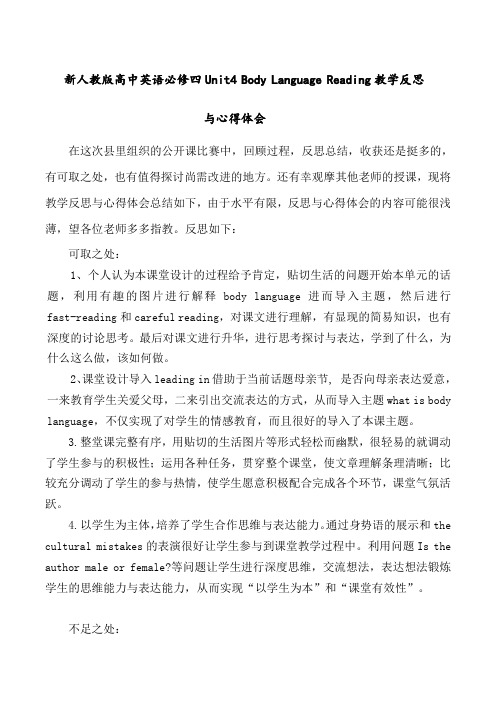
新人教版高中英语必修四Unit4 Body Language Reading教学反思与心得体会在这次县里组织的公开课比赛中,回顾过程,反思总结,收获还是挺多的,有可取之处,也有值得探讨尚需改进的地方。
还有幸观摩其他老师的授课,现将教学反思与心得体会总结如下,由于水平有限,反思与心得体会的内容可能很浅薄,望各位老师多多指教。
反思如下:可取之处:1、个人认为本课堂设计的过程给予肯定,贴切生活的问题开始本单元的话题,利用有趣的图片进行解释body language 进而导入主题,然后进行fast-reading和careful reading,对课文进行理解,有显现的简易知识,也有深度的讨论思考。
最后对课文进行升华,进行思考探讨与表达,学到了什么,为什么这么做,该如何做。
2、课堂设计导入leading in借助于当前话题母亲节, 是否向母亲表达爱意,一来教育学生关爱父母,二来引出交流表达的方式,从而导入主题what is body language,不仅实现了对学生的情感教育,而且很好的导入了本课主题。
3.整堂课完整有序,用贴切的生活图片等形式轻松而幽默,很轻易的就调动了学生参与的积极性;运用各种任务,贯穿整个课堂,使文章理解条理清晰;比较充分调动了学生的参与热情,使学生愿意积极配合完成各个环节,课堂气氛活跃。
4.以学生为主体,培养了学生合作思维与表达能力。
通过身势语的展示和the cultural mistakes的表演很好让学生参与到课堂教学过程中。
利用问题Is the author male or female?等问题让学生进行深度思维,交流想法,表达想法锻炼学生的思维能力与表达能力,从而实现“以学生为本”和“课堂有效性”。
不足之处:1. 学生思考的广度不够,阅读中停留在reading for information较多,而缺少reading for thinking,教学过程中基本上基于信息找寻的问题居多,而进行深入思考的的问题过少而且范围狭窄。
- 1、下载文档前请自行甄别文档内容的完整性,平台不提供额外的编辑、内容补充、找答案等附加服务。
- 2、"仅部分预览"的文档,不可在线预览部分如存在完整性等问题,可反馈申请退款(可完整预览的文档不适用该条件!)。
- 3、如文档侵犯您的权益,请联系客服反馈,我们会尽快为您处理(人工客服工作时间:9:00-18:30)。
II. Teaching Aims
(教学目标)
Make students learn the key words and Knowledge sentences. aims
Ability aims
a.Able to use skimming and skinning skill to look for general idea. a.b.Able to search information about different cultures through various channels
(自主学习法)
Teaching methods and studying ways
(教法和学法)
Corporation (合作交流)
Inquiry learning (探究学习)
V. Teaching Procedure(教学过程)
Step 1. Leading--in
Step 2. Brainstorming
Britain Japan Jordan
设计意图 在预习基础上训练学生快速阅读的 能力,从整体上把握好文章。
Fast reading :
Find the characters and where they are from?
Character Mr. Garcia
Country
Columbia
Britain
the statement is true or false
1 Only Australia and central America are not represented by the visitors. (F) 2 Not all cultures greet each other the same way, Para. 3-6 so people everywhere act the same. (F)
purpose mistakes
interest
People from different countries misunderstand each other.
3 what does the word mistake mean?
● Read Para 3-6 again and decide whether
Ok! Or zero
Step 3. While--reading Listening find the characters and where they are from?
Character Mr. Garcia
Mr. Cook A Japanese Madame Coulon You
Country
Step 3. While-reading
Step 4. Post-reading
Step 5. Discussion /Assessment
Reading
COMMUNICATION: NO PROBLEM?
Step 1. Leading--in
设计意图
观看影片,活跃气氛,激发学生对身势语的好奇心,引出话题
Unit 4 Body Language(reading) Communication: No problem
Communication: No problem
The analysis of teaching materials and students Teaching aims
Teaching focus and difficulties
Analysis of the students
They show little interest in learning English, and they are lack of confidence. So, during the teaching process, the teacher should focus on how to arouse their interest in English. In addition, the teacher should teach them the proper way to learn English and encourage them to learn English well.
III. Teaching focus and difficulties
(教学重难点)
1.Develop students' reading skills by extensive reading. 2.Have students understand the difference and similarity of the body language in many parts of the world.
(variety) 3 Julia Smith is surprised because Mr. Garcia touches her shoulder and kisses her. (T)
4 French people will often bow and kiss people they know on both cheeks. (F) 5 The main character is female.
设计意图
(F )
引导学生分析课文,抓住关键词,概况文章的细节。
Find out the two mistakes the writer found in the airport:
He approaches Ms Smith Mr. Garcia by touching _______ ______ her from The _________ _______ shoulder and kissing (Columbia ) first her on the ________. cheek mistake She ______ stepped ________ back Julia Smith appearing surprised _________ from and take a few steps (Britain) away from _______ ______ Mr. 设计意图 Garcia. 通过填写表格培养学生的理解能力和概况能力,培养和提高学生的
The topic of this Unit is “ Body Language ” . The passage titled Communication: No problem?, mainly introduces one incident when author received international students and observing the interesting scene about their different greeting ways to each other. And the body language, which we usually use in daily life as a form of communication, actually reveals different cultures in the author ’ s eyes. By learning this passage, not only do students broaden their horizon on intercultural communication, but also they could understand the importance of body language in social intercourse.
Julia Smith
Mr. Cook A Japanese
Canada
Japan Jordan
Ahmed Aziz
Madame Coulon You
France
China
Main idea
Para 1-2 You are going to meet business
people from several countries. Not all cultures greet each other the same way. A conclusion of the passage.
阅读能力和技巧。
a Japanese The second mistake
George Cook from (Canada)
He ________ bowed to Mr. Cook and his nose touched Mr. _________ moving Cook’s _______ ________. hand He ________ reached his hand ________ _______ ________ to the out Japanese.
people from different countries
Para.1-2 (example)
people present local businessmen
people representing the Chinese government
2 Why are people visiting China?
Communicative language teaching
method
Teaching methods and studying ways
(教法ቤተ መጻሕፍቲ ባይዱ学法)
Situational teaching method Task-based teaching
method.
Individual learning
Discussion
What does the following sentence mean? What can we learn from the whole passage? None of these actions is either good or bad.
